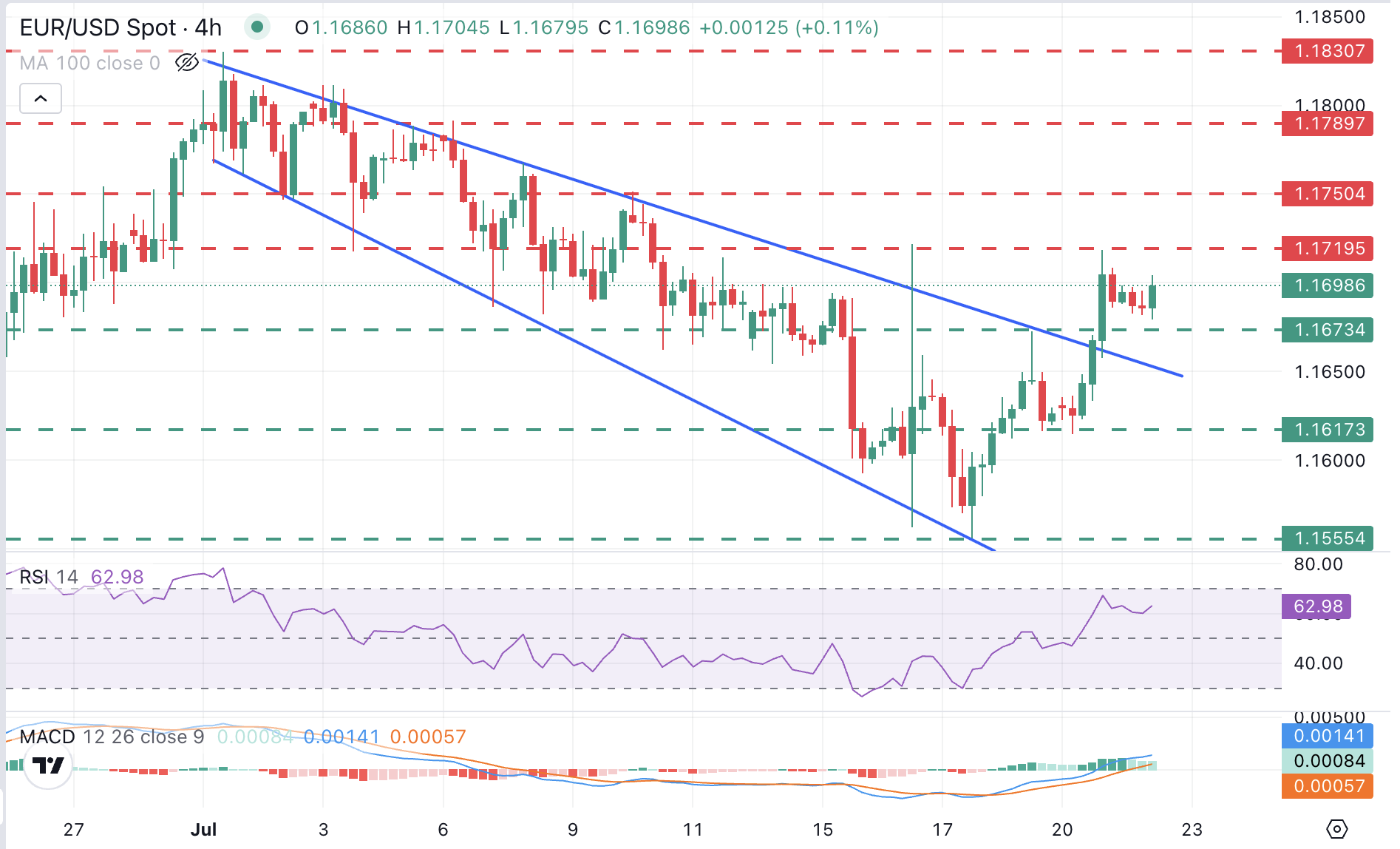- The euro slides down but maintains most of the profits after the rally of the last two days.
- The US dollar has lost impulse to the growing concerns about Trump’s tariffs.
- The president of the FED, Powell, will speak on Tuesday in the midst of pressures to resign by President Trump.
The Eur/USD It maintains profits after a quite positive loan survey of the European Central Bank (ECB), published earlier on Tuesday, in the middle of a trading session in general cautious, while investors expect news about commercial negotiations between the European Union (EU) and the United States (USA).
The euro (EUR) has become positive in the daily chart and is currently quoted at 1,1695. The pair remains above Friday’s maximum, in 1,1675, and also above the top of a bearish channel from the maximum of July 1, which suggests that greater appreciation is likely.
The ECB survey indicates that commercial tensions did not impact credit standards, and the demand for mortgage and corporate credit increased in the second quarter, with expectations of more increases in the next three months. These figures arrive after another optimistic report on access to financing published on Monday.
These reports are contributing to support the euro near the maximum of 10 days, although the upward attempts are limited on Tuesday, since the appetite of investors for the risk remains weak, with the commercial uncertainty weighing on the feeling as the tariff deadline of August 1 without significant advances in the negotiations is approaching.
The representatives of the EU and the USA continue to negotiate in an attempt to reach an agreement, but the hopes of a successful result decrease day by day. Recent comments on the European side reflect that confidence in an agreement is decreasing and the block is exploring retaliation measures. Some countries are considering broad measures against coercion aimed at US services in response to the high unilateral tariffs announced by US President Donald Trump.
Later in the day, the speech of the president of the Federal Reserve (FED), Jerome Powell, in Washington, will attract some attention. It is not expected that the president of the FED comments on monetary policy, since the Fed is in its period of silence before the decision on the interest rates of July 30, but its reaction to the unprecedented pressures of the US administration could have some impact on the market.
Euro price today
The lower table shows the percentage of euro change (EUR) compared to the main currencies today. Euro was the strongest currency against the New Zealand dollar.
| USD | EUR | GBP | JPY | CAD | Aud | NZD | CHF | |
|---|---|---|---|---|---|---|---|---|
| USD | -0.03% | 0.02% | 0.19% | -0.00% | 0.21% | 0.34% | -0.10% | |
| EUR | 0.03% | 0.08% | 0.24% | 0.04% | 0.23% | 0.46% | -0.05% | |
| GBP | -0.02% | -0.08% | 0.16% | -0.03% | 0.16% | 0.33% | -0.13% | |
| JPY | -0.19% | -0.24% | -0.16% | -0.17% | 0.00% | 0.23% | -0.35% | |
| CAD | 0.00% | -0.04% | 0.03% | 0.17% | 0.19% | 0.38% | -0.09% | |
| Aud | -0.21% | -0.23% | -0.16% | -0.01% | -0.19% | 0.18% | -0.33% | |
| NZD | -0.34% | -0.46% | -0.33% | -0.23% | -0.38% | -0.18% | -0.50% | |
| CHF | 0.10% | 0.05% | 0.13% | 0.35% | 0.09% | 0.33% | 0.50% |
The heat map shows the percentage changes of the main currencies. The base currency is selected from the left column, while the contribution currency is selected in the upper row. For example, if you choose the euro of the left column and move along the horizontal line to the US dollar, the percentage change shown in the box will represent the EUR (base)/USD (quotation).
What moves the market today: the US dollar loses land in the midst of commercial uncertainty
- The US dollar seems to have lost the bullish impulse observed in recent weeks. The green ticket is uploading on Tuesday, but the reversal of the last two days suggests that the market is beginning to get anxious to the impact of tariffs as the deadline of August 1 is approaching.
- In the absence of key macroeconomic publications, the continuous attacks of the US administration to the president of the FED, Jerome Powell, continue to attract the attention of investors, eroding the independence of the Central Bank of the US and the status of the US dollar as a reserve currency.
- In the Eurozone, on Monday, a ECB survey about access to financing showed that European companies are optimistic about their growth prospects, although cautious about the possible impact of commercial tensions. The euro was appreciated after the publication of the survey.
- Investors will also be attentive to the quarterly profits of the technological giants Alphabet and Tesla, while in Europe, the results of SAP, the largest software manufacturer in the region, will provide some clues about the impact of a strong currency on the income of European companies.
EUR/USD breaks over the resistance of the trend line and look at 1,1720

EUR/USD He is showing a growing bullish impulse after breaking the top of a bassist trend channel from the maximum of July 1. The pair is going down slightly on Tuesday, but the technical indicators point up with the 4 -hour relative force index and the MACD moving within the upward territory.
The immediate resistance is located in 1,1720, which limited the Alcistas on Monday, before the maximum of July 10 in 1,1750 and the maximum of July 7 in 1,1790.
Down, the pair could find support in the maximum of July 18 in 1,1675, but a test of the reverse trend line should not be ruled out, now in 1,1655. A bearish reaction below that level would cancel the upward perspective and take the minimum of Monday, in 1,1620, to the focus.
Tariffs – Frequently Questions
Although tariffs and taxes generate government income to finance public goods and services, they have several distinctions. Tariffs are paid in advance in the entrance port, while taxes are paid at the time of purchase. Taxes are imposed on individual taxpayers and companies, while tariffs are paid by importers.
There are two schools of thought among economists regarding the use of tariffs. While some argue that tariffs are necessary to protect national industries and address commercial imbalances, others see them as a harmful tool that could potentially increase long -term prices and bring to a harmful commercial war by promoting reciprocal tariffs.
During the election campaign for the presidential elections of November 2024, Donald Trump made it clear that he intends to use tariffs to support the US economy. In 2024, Mexico, China and Canada represented 42% of the total US imports in this period, Mexico stood out as the main exporter with 466.6 billion dollars, according to the US Census Office, therefore, Trump wants to focus on these three nations by imposing tariffs. It also plans to use the income generated through tariffs to reduce personal income taxes.
Source: Fx Street
I am Joshua Winder, a senior-level journalist and editor at World Stock Market. I specialize in covering news related to the stock market and economic trends. With more than 8 years of experience in this field, I have become an expert in financial reporting.







